Elder abuse is any act within a relationship of trust that results in harm to an older person. The abuse may be emotional, psychological, financial, physical, sexual, or neglect. According to the World Health Organization, elder abuse is a violation of human rights and a significant cause of illness, injury, loss of productivity, isolation and despair.
Introduction
Elder abuse is any act within a relationship of trust that results in harm to an older person. The abuse may be emotional, psychological, financial, physical, sexual, or neglect. According to the World Health Organization, elder abuse is a violation of human rights and a significant cause of illness, injury, loss of productivity, isolation and despair.
Many people do not discuss their concerns with others because of feelings of shame, fear of retaliation or because the perpetrator may by a family member. Some people may not realise that they are experiencing abuse, or feel that somehow it is their fault.
Elder abuse is one part of a spectrum of violence that occurs when there are unequal power relationships. Family violence research tells us that where imbalances of power occur in relationships there is a risk of abuse occurring from the dominant person or persons. These power differences have been interpreted, particularly in relation to family violence, as the result of living in a patriarchal or male orientated society where males and male values dominate. While in all age groups, the majority of those being abused are female and the abusers are mainly male, this gendered view of violence and abuse becomes blurred somewhat when the abuse occurs in older populations.
In January 2016 Relationships Australia asked visitors to our website a few questions about their experience and understanding of elder abuse in the monthly online two minute survey.
Previous research finds that…
- It is projected that there are over 100,000 unreported cases of elder abuse, neglect, and exploitation in Australia per year.
- Almost four times as many new incidents of elder abuse, neglect, and exploitation are not reported as those that were reported to, and substantiated, by adult protective services agencies and/or ombudsman entities.
- Among known perpetrators of elder abuse and neglect, the perpetrator is a family member in 90 per cent of the cases.
- Two-thirds of the perpetrators of elder abuse are adult children or spouses.
- By 2025 it is estimated that elder abuse will be costing the health system over $350 million dollars per year.
Results
More than 1650 people responded to the Relationships Australia online survey in December. More than four-fifths of survey respondents (81%) identified as female.
As was the case for last month’s survey, more females than males responded in every age group (figure 1). More than ninety-five per cent (97%) of survey respondents were aged between 20‑59 years, with the highest number of responses collected for women aged between 30-39 years (inclusive).
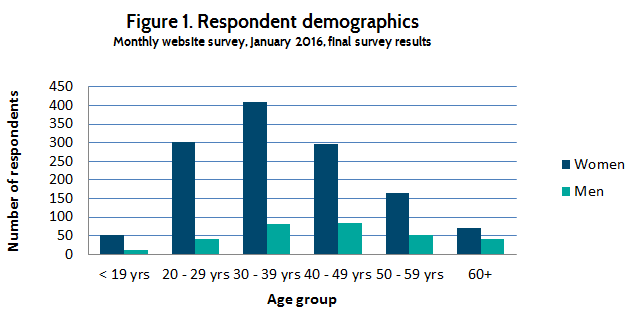
The demographic profile of survey respondents remains consistent with our experience of the people that would be accessing the Relationships Australia website.
Survey respondents were asked whether they had concerns about an older person who may be experiencing elder abuse (figure 2). Just under one-third (30%) of survey respondents reported concerns about an elderly friend or relative experienceing elder abuse, with women more likely to report concerns than men.
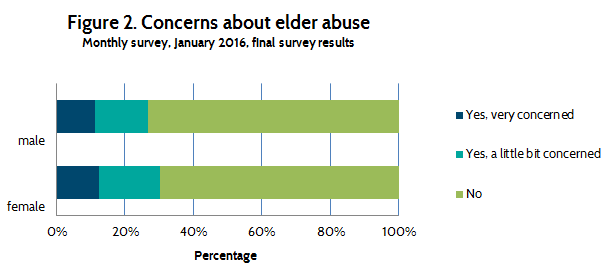
Just under seventy per cent (67%) of survey respondents identified greed and a sense of entitlement as a contributing factor to elder abuse. The next most common factors included the poor physical and mental health of older people (49%) and abusers (43%), and the financial problems of the abuser (42%).
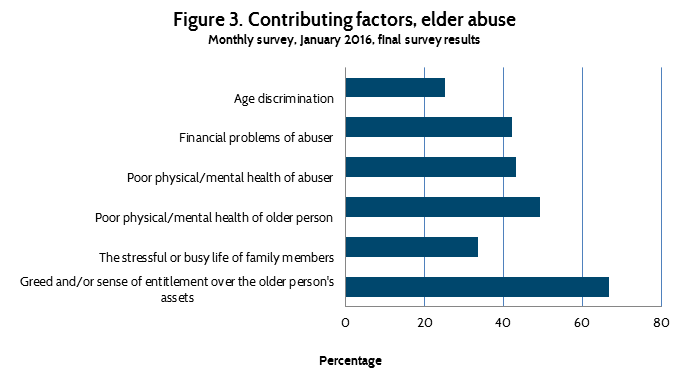
Survey respondents reported that they thought the most likely perpetrators of elder abuse were the partners or spouses of the older person, their sons or daughters. Female survey respondents were more likely to report sons (25% compared with 19%) as the most likely perpetrators of elder abuse, while men were more likely to report that they thought partners (25% compared with 22%) or daughters (17% compared with 10%) were the most likely perpetrators of elder abuse (figure 4). The percentages attributed to sons and daughters are significantly lower than the estimated 90 per cent of elder abuse attributed to adult children in the extant research.
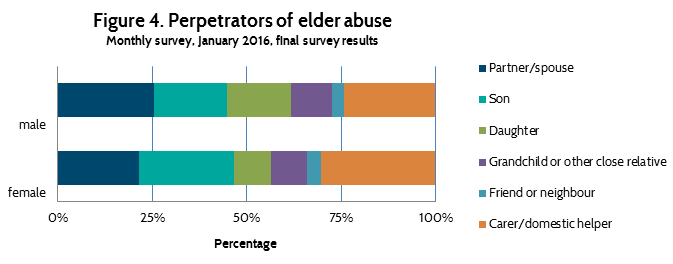
Very few survey respondents reported that they wouldn’t do anything if they suspected elder abuse (figure 5). Men were more likely than women to indicate they would speak to the abuser (12% compared with 6%), while women were more likely than men to report that they would speak to the older person (25% compared with 21%). Just over forty per cent of men and women survey respondents indicated that they would report their suspicions to the police or a community organisation.
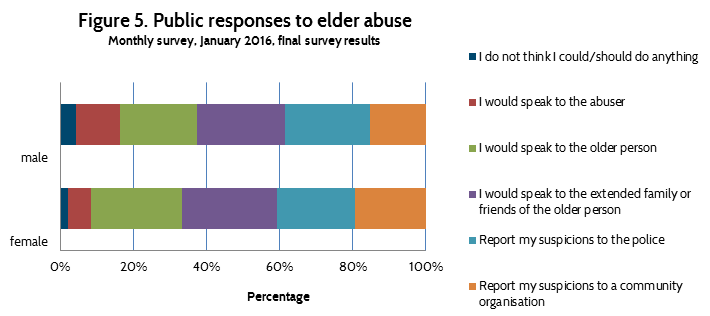
References
http://www.seniorsrights.org.au/toolkit/toolkit/what-is-elder-abuse/